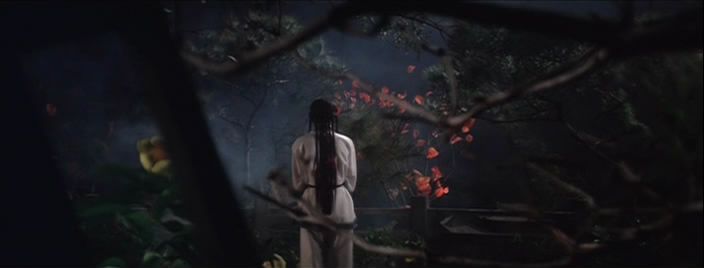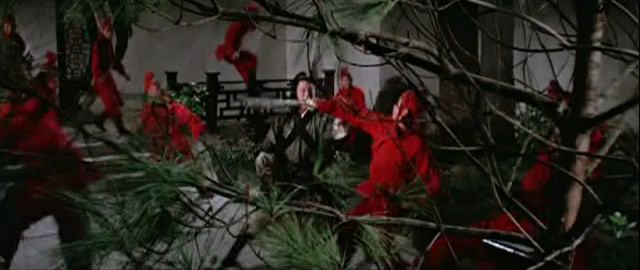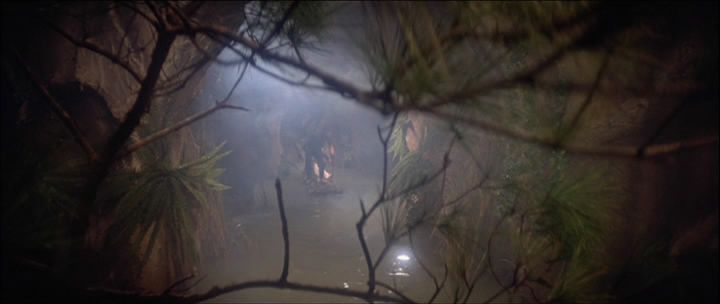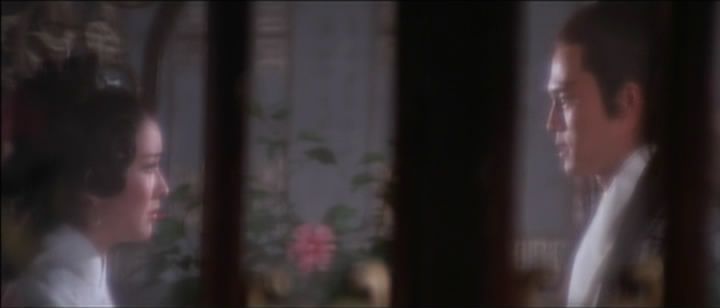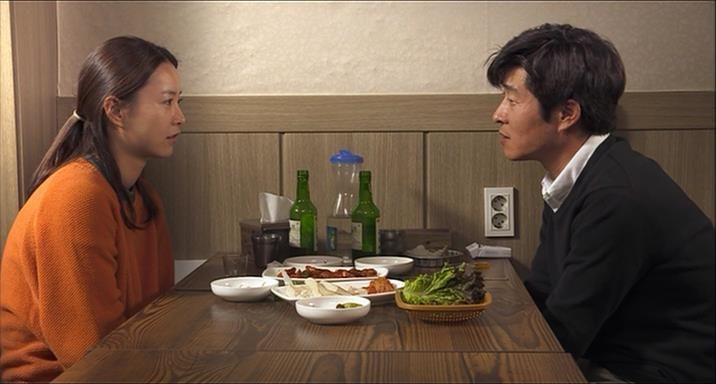Shoegaze, in movies moody enough for indie sensibilities, usually goes together with scenes of long, meandering midnight drives across abstracted cities. This particular form of 90s music, once marginalized in its heyday by the rise of grunge, found a new home in a particular form of noughties cinema. The dreamlike melodies of shoegaze, made weightless not only through the endless droning fuzz of electric guitars but also through the virtual absence of bass, lulls the senses to a sleepwalk state of mind, which corresponds to and resonates with the angst-ridden, melancholic characters of indie-dom, who linger on fragile and sluggish by some heartbreak tucked away deep within, watching the downtown lights flash on by on their nonstop journey to nowhere. Dreamy music over droopy looks, from the final moments of
Adventureland to the opening scenes of
Ang Nawawala, works like a magic charm; in its many appearances, this audiovisual combination conveys in shorthand the emotional tenor of the main characters with the least amount of inelegance.
Lost in Translation concisely outlines this combination, provides its set model as well as an affective blueprint from which numerous indie films over the years have tried desperately to emulate. Sofia Coppola, not surprisingly, enlisted the talents of My Bloody Valentine frontman and shoegaze legend Kevin Shields for the soundtrack, and one of the more striking moments in the film occurs when one of his finest songs (“Sometimes”) swiftly breezes in over an inebriated scene: Scarlett Johansson and Bill Murray, both tipsy from a night out painting the town red, rest their heads on the windows of a taxi taking them home, looking out at Tokyo only as a muddled series of colors, lights, and neon signs they can never understand. In reality, the two are only an insignificant speck in the vast electric metropolis of Tokyo, but the music over this scene allows, if only for an instant, the outside world to revolve around these lost souls.
Now let us speculate more on these characters, look through their eyes, and go under their skin, so that we may trace some of the complex ways in which music combines with images. Inside the cab, the characters in
Lost in Translation are sealed off from the outside world, stuck in sensuous somnolence, tuned in to their own private atmosphere, while outside roams nighttime Tokyo excessive and wild, too much for these Westerners to handle. Yet no matter how cut off these characters are from what lies outside, the music covering this sequence becomes a saving grace, providing a likely passageway through which these static characters can for once move beyond their tiny selves ? but only on the condition that what lies beyond must be represented under their own terms. “Sometimes” becomes the thin, tenuous line of connection between the couple and the city, allowing them to absorb according to their whims what they previously had no kinship to into something wondrous, transforming Tokyo into a somnambulist’s paradise, the two of them pulling all these figures flashing by outside their reach into their personal, lonesome logic. Nonetheless, in this enchanting union of sound to image, an uneven relationship is immediately established as soon as the couple’s private atmosphere, emotionally conveyed through the song (“
Close my eyes/
Feel me now/
I don’t know how you could not love me now”), overrides the entire scene, because now Tokyo and its people, their varieties and complexities, are droned out by the music, eclipsed by the self-absorbed stupor of the couple, gift-wrapped according to their desires.
Lost in Translation, like its main characters, is perhaps too content in remaining alienated from the rest of the world, but its estranged point of view carries a shy, wistful allure, especially when the couple scurries round this city of a thousand lights, which the film connects with only in a specious manner, making false contact with the city most of all when music is in the air.
From this example, the creative combination of music over images, in its attempt to accentuate the complicated emotions of the characters, smoothes down the multiplicities of people and place present within the images, putting all the figures in the sequence on the same plane as it were. Of course, this is a question of montage as much as it is a question of music; for now, we can suggest that the relationship between music and images goes something like this: montage gathers scenes, while music can unify them into a particular pattern. In the same vein as
Lost in Translation, the 1985 music video for “We Are the World” gathers two separate strands of images, one interior the other exterior, the singers of USA for Africa inside the recording studio and the starving African children outside in the savannah, so that the anthem which follows will unite, at least in representation, those inside with those outside, or in Serge Daney’s words make “the dying and the famous dance together”. However, as said before, this unity, this connection is a false one, and “We Are the World” presents an even more extreme example of the
Lost in Translation syndrome, where music and montage relegates the outside world to the impulses of the main players. Unlike Sofia Coppola’s film, where Tokyo is only an open car door away, USA for Africa, comfortable and all smiles, are nowhere near the starving children of Africa whose images follow from theirs, and instead of letting the music speak
over these kids, in the same way the lonesomeness of Kevin Shields’ score covers over Tokyo, the singers hypocritically speak
for them: “We are the world, we are the children”. Few things have surpassed the thoughtlessness of “We Are the World”, and Daney is once more present to express the indignation at this careless arrangement of music and image:
“The rich singers (“We are the world, we are the children!”) were mixing their image with the image of the starving. In fact, they were taking their place, replacing them, erasing them. Dissolving and mixing stars and skeletons in a kind of figurative flashing where two images try to become one, the video elegantly carried out this electronic communication between North and South.”
And this profane combination of music and image finds its way into the present day with the globetrotting goofballs of One Direction, whose self-made “One Way or Another (Teenage Kicks)” music video, created for the purposes of charity in the same manner as “We Are the World”, would surely make Daney roll in his grave. Even though these pop stars share the same space with their fans across the world, whether in Ghana, New York, Tokyo, or even 10 Downing St., these diverse places, strung together by the music like beads in a necklace, never amount to anything other than background fodder for the band’s comic antics or momentary shrines dedicated to their widespread fame. And the images that represent these places, from African kids smiling in the hovels of Ghana to the odd and colorful teenage cosplayers in Tokyo, reduces all their complexities into easily recognizable stereotypes, so that it relieves the viewer the trouble of considering the many multiplicities suppressed within this sequence of images and allows them to freely sing along with the Blondie/ Undertones mash-up. Differences are thus rubbed out, the varieties of people and place flattened into mush, and everywhere and everyone is put in the same relegated position, becoming part of the monotonous backdrop for One Direction’s world supremacy.
What links
Lost in Translation, “We Are the World”, and “One Way or Another (Teenage Kicks)” in this daisy chain of music-image combinations is an inventive scheme where music
infuses images. Here music unifies the images collected by montage into a pattern of dominance and submission, where a dominant set of figures (Scarlett Johansson and Bill Murray, USA for Africa) infuses a set of subordinate figures (Tokyo, African children) with something that is not theirs (“Sometimes”, “We Are the World”), and so this scheme can either imaginatively transform entire spaces into personalized zones of feeling (
Lost in Translation) or, at its dangerous limit, erase the crucial intricacies of the outside world (“We Are the World”, “One Way or Another (Teenage Kicks)”). In the scheme of infusion, the subordinate set of figures are either spoken over or spoken for, but both these options involve, in varying degrees, the erasure of these figures, substituting them with whatever the dominant figures have in mind. So when music covers over the outside, infusing it in the process, something in the representations gets erased, and infusion seems most ethical when it stays within the four walls of its dominant figures, like the FX driver in
MNL 143, listening to a ballad on the car radio and weeping his heart out, while the camera is glued to his face, never cutting away to an exterior shot
― but this is not infusion any longer. For infusion to move past its dangers, where music becomes the running thread of erasure over images, it cannot remained tied down to the private atmospheres of the main players, whether it is the couple sheltered inside the taxi or the menagerie of 80s singers grooving inside the studio, because it must move beyond them, shattering the privacy of the moment, spreading outwards in all directions to the outside world, rousing a true gathering where everyone shares in an emotion, feeling, sensation, ceasing to be infusion altogether. Here music no longer infuses, music
suffuses.
Social events usually characterize the scheme of suffusion, from the morning routines of Maurice Chevalier’s neighbors synchronizing in perfect rhythm for the blissful opening number of
Love Me Tonight to the teenage hippies, hopped up on acid, alcohol, and adrenaline, burning up the night sky in Olivier Assayas’
Cold Water. Music, travelling from image to image, carries over states of feeling. In the scheme of infusion, these concentrated feelings more often than not belong to the main characters and exclude all the other figures on the screen, unless their minute presence is covered over by the music; meanwhile suffusion tries, as much as possible, to include all the figures onscreen to join in with all these high emotions. The opening number of
Love Me Tonight is a benchmark in the scheme of suffusion: the snores of a bum awakes an entire city, and soon housewives are opening up windows, letting the sun in, storeowners begin opening shop, and leading man Maurice Chevalier starts dressing up for his morning saunter round the streets of Paris, as the musical élan has spread far and wide throughout this public world, giving every individual all across the city the right to be a part of this gathering. Another example is Jacques Demy’s masterpiece
The Young Girls of Rochefort, whose whole energy, characterized by Michel Legrand’s jazzy score, is spread all around, from the town square all the way to the little private rooms of the lead characters, as song and dance never really ends in this crazy town. It is apparent that the scheme of suffusion has utopian aspirations, to gather all the figures represented on the screen and create a community, no matter how temporary, based on the music in which everyone shares, yet, like infusion, suffusion also has its limitations. Suffusion needs to remain mobile, as unsettled as possible, changeable in an instant, for all the merriment and spontaneity in the scheme of suffusion has the potential to be permanently dictated, like soldiers marching to the drumbeat, by the set music and the emotion it carries.
The Young Girls of Rochefort, with its unstable changes in emotion, from lovelorn melancholy to utter bliss, and figures moving in and out of the song and dance numbers at their choosing, never falls into this trap, unlike the icy revue numbers of Busby Berkeley musicals which, no matter how fascinating and memorable, remain mechanized, choreography created by a watchmaker. At its limits, suffusion becomes something like the orgiastic passages in Thomas Pynchon’s novels, especially one in
Gravity’s Rainbow with its distinct and disturbing apocalyptic glow:
“And they do dance… they feel quite in touch with all the others as they move, and if they are never to be at full ease, still it’s not parade rest any longer… so they dissolve now, into the race and swarm of this dancing Preterition, and their faces, the dear, comical faces they have put on for this ball, fade, as innocence fades, grimly flirtatious, and striving to be kind.”
In this social event, with its utopian promise, suffusion dissolves people, similar to what happens in the scheme of infusion. In order to move away from the potential dangers of suffusion, it needs to share some of the qualities of its opposite, infusion, so that it can create moments and events where everything is shared but nothing remains on the same plane, where nothing is given complete emphasis but every figure, as much as possible, is given equal emphasis so that nothing is given to erasure. Infusion and suffusion must merge; musical moments should have the capacity to move in and out of these two schemes. Thankfully, the cinema, from all around the world, has given us so many examples of this infusion-suffusion combination, and what can become of their multiple possibilities.
In
Beat Street (produced by Harry Belafonte, the same man behind “We Are the World”), two young break-dance groups duke it out in the middle of the dance floor while the DJ squeezes out some ‘80s hip-hop beats to accompany this electric dance battle as the crowd surrounding them oohs and aahs. The dancers go back and forth like an alternating current, trading dance moves like jabs, hooks, and uppercuts, as the scene, with its clunky shot/ reverse shot pattern, seems to extend into eternity, a battle with no end in sight. But suddenly, invisibly, the battle ends, the enclave of the dancers dissolves, and as soon as the DJ changes tracks the dancing, previously concentrated solely on the two groups, spreads throughout the whole discotheque, its intensities burning up the scene like wildfire. Here the atomized energy of the two break-dance groups suddenly diffuses onto the entire dance floor, as infusion moves into suffusion.
The reverse movement, from suffusion into infusion, occurs in two completely different films: Jose Luis Guerin’s
In the City of Sylvia and the South Korean box office smash
Sunny. Near the end of Guerin’s film, our disenchanted protagonist wanders into a bar, ogling all the mysterious and slightly tipsy women inside only to be rejected by them afterwards, as the radio in the background transitions from Blondie’s “Heart of Glass” to a Migala’s “That Woman”, from suffusion into infusion. With the Blondie song, we see the inhabitants of the bar, the couples, girlfriends, and loners, grooving to the song, while our protagonist cozies up to another woman; at the moment of her rejection, “That Woman” is now in the air, as our protagonist guzzles down another drink, succumbing to tonight’s lonesome fate, until, at the minute the songs hits its instrumental break, something catches his eye: a woman, almost a vampire, clad in the most goth outfit imaginable, who suddenly returns his gaze, as the two of them stare deeply into each other’s eyes, and our protagonist is lonely no more. Another scene set inside a bar, the teenage heroine of
Sunny searches for her twentysomething crush as the camera details all the smoke, booze, bad music, and every annoyance an underage girl faces upon entering a bar. Just when she is about to give up on her search, a pair of hands, emerging from off-screen, clamps a set of headphones on the girl’s ears, and on the soundtrack the middling music inside the bar switches to the ‘80s ballad on the headphones, and as the girl turns to see the person who did this the scene swiftly cuts to a master shot showing the girl and her crush spotlit at the center of the bar, their private moment the center of the scene.
A miracle, a boy ― she cannot help but blush.
Sometimes, when merged in an imaginative way, infusion and suffusion become interchangeable. Anna Karina’s torch song in
Band of Outsiders is equal parts infusion, equal parts suffusion. Her song, emerging from the depths of the Parisian subway and broadcasted over documentary images of the wastrels in the streets above, could be classified simply as infusion, since her soft voice covers over images of others, if it was not for the manner in which Jean-Luc Godard tied these separate images, Karina and the bums, into a poetically charged moment where the bums speak for Karina as much as Karina speaks for them, for they both signify and share the same aimless, timorous, falling-rain melancholy that is the tone of
Band of Outsiders. Meanwhile in
Sansho the Bailiff, we hear a song, a mother’s lament to her children, echoing past space and even time, as the mother’s cry for her lost children reaches one of them when he’s now a young man. It is a private moment between mother and child, spread across an immeasurable distance, but in this war-torn landscape, in a history written in blood, the aching song which infuses these images is synonymous with the tragedy of almost all the figures in the film, and thus, in the same manner as the Godard film, infusion is indistinguishable from suffusion.
Music travels through images, transporting the emotion it carries through infusion, suffusion, or a merger of both, tracing out the private moments of loneliness to the shared utopia of a dance number, and only one of the many possibilities of cinema’s melody, the combination of music and moving pictures. Tsui Hark’s
Shanghai Blues boasts my favorite instance of cinema’s melody. From his apartment rooftop, violinist Kenny Bee blasts the Shanghai blues, while on the floor below Sally Yeh tunes in to this haunting melody, as does the rest of Shanghai, from hobos, whores, drunks, all glancing upward wondering who is creating this mysterious melody, which finds its way to every nook and cranny of the city, whose inhabitants are dreaming through this song, moved because of it, animated by it in such a manner that the entire city, through some ingenious trick photography, soon merry-go-rounds Sally Yeh as she begins to fall in love with the mysterious man above playing the blues. No matter how far they are or how well they hide, here music gathers the public and the private, the emotional intensities of a city sharing in a moment of wonder and the personal blooming of young love on the floor below, in a utopian instant reminiscent of the communal promise of disco, as well as the songs of its queen, Donna Summer:
Love will always find you
No matter where you hide
Love is gonna find you
And it’s only just a matter of time
(…)
Love will always find you
No matter where you are
Love is gonna reach you
Cause it’s never really that far

